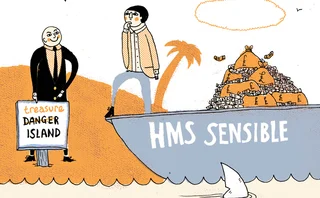
Credit where it's due
IFRS 9 sweeps away centuries-old accounting conventions; banks look to frontload capital hit

Implementation of International Financial Reporting Standard 9 (IFRS 9) on January 1, 2018 will mark a sea change in centuries-old accounting conventions, and will force banks to dramatically increase provisioning against loans that are at risk of turning sour.
The regime and its US analogue, the Current Expected Credit Loss (CECL) rule, usher in a shift to expected credit loss (ECL) accounting in favour of the current incurred losses approach – in which a loan is recorded as healthy on a bank’s books up until the point of impairment. Under IFRS 9, dealers will be required to calculate ECL for all loans over a 12-month period, and over the entire lifetimes of loans that have deteriorated in credit quality.
For some banks, the jump in loan-loss provisioning under the regime could be as much as 30% versus current levels according to some estimates – potentially forcing banks to divert retained earnings or dip into their own capital buffers. The result could be a hit to Common Equity Tier 1 capital of up to 45 basis points, according to one study.
IFRS 9 buckets loans into three stages – stage 1 for healthy loans, stage 2 for underperforming loans and stage 3 for impaired loans. Where a loan’s probability of default (PD) rises between reporting periods, banks must increase provisioning accordingly. Banks fear that, should a sudden sustained economic downturn affecting multiple sectors occur between reporting dates, they may be forced to downgrade loans by a stage en masse, with the attendant steep rise in provisioning potentially leading to capital shocks.
As Nimesh Verma, director in bank advisory, corporate and institutional banking at BNP Paribas, notes: “IFRS 9 significantly increases volatility and procyclicality. It amplifies provision levels and drives large shifts in regulatory capital on an ongoing basis, as changes in economic outlook mean swaths of assets move between stages 1 and 2.”
Some lenders aren’t waiting for a downturn in macroeconomic conditions to dictate matters for them – several are already considering pre-emptively downgrading loan books that are most at risk of a rise in PD by shifting them into the next bucket down, effectively front-loading any resultant capital hit and helping smooth profit and loss volatility.
Regulators are also cognisant of the risks incurred if banks under their watch suffer hits to their capital and earnings, and have made efforts to phase the rules in more slowly as a result. Recent moves by the Basel Committee on Banking Supervision to give local regulators more latitude in this regard have also been welcomed by the industry.
The other main cost for banks in complying with the rules has been a significant retooling of loan-loss modelling capabilities to accommodate the shift to the ECL regime. This is where some banks have looked to lighten their load by repurposing existing credit risk capital models to provide the point-in-time estimates required under IFRS 9, where losses are calculated across fixed time horizons – either one year or over the lifetime of the loan. In this sense, banks that have opted to use the Basel II internal ratings-based approach for calculating credit risk capital requirements will be at an early advantage.
Only users who have a paid subscription or are part of a corporate subscription are able to print or copy content.
To access these options, along with all other subscription benefits, please contact info@risk.net or view our subscription options here: http://subscriptions.risk.net/subscribe
You are currently unable to print this content. Please contact info@risk.net to find out more.
You are currently unable to copy this content. Please contact info@risk.net to find out more.
Copyright Infopro Digital Limited. All rights reserved.
As outlined in our terms and conditions, https://www.infopro-digital.com/terms-and-conditions/subscriptions/ (point 2.4), printing is limited to a single copy.
If you would like to purchase additional rights please email info@risk.net
Copyright Infopro Digital Limited. All rights reserved.
You may share this content using our article tools. As outlined in our terms and conditions, https://www.infopro-digital.com/terms-and-conditions/subscriptions/ (clause 2.4), an Authorised User may only make one copy of the materials for their own personal use. You must also comply with the restrictions in clause 2.5.
If you would like to purchase additional rights please email info@risk.net
More on Corporates
Indian corporates count forex losses from rupee depreciation
Living on the hedge
Corporate cash seeks new home as money-market reforms loom
New regulation on both sides of the Atlantic threatens to make money-market funds less attractive for corporate treasurers. Banks are hoping this cash will flood into fixed-term deposits instead, helping them meet incoming liquidity ratios, but they’re…
Risk 25: How Basel III is turning borders into barriers
Turning borders into barriers
Treasurers highlight unintended consequences of regulation
Corporate treasurers complain about the unintended consequences of the proposed financial transaction tax, as well as clearing rules for OTC derivatives
Corporate backlash on costs of regulation continues
Banks will not be able to avoid passing on the hefty costs of regulatory reform to their buy-side clients, argued participants at the ACI UK’s annual square mile debate
Prepare for further black swan events in FX, corporates told
Corporate treasurers should make sure their forex counterparties are properly prepared for the possibility of further black swan events in the foreign exchange markets, senior Lloyds banker tells ACT conference delegates in Manchester
Corporate profile: Containing risk at China’s CSCL
Containing risk
Deutsche-Ille ruling changes sales practices for German dealers
Accentuate the negative








